The Great White Shark is best known for his role in the movie Jaws. This shark is known as the most dangerous in the ocean, which is a true fact. The bloodthirsty image of this magnificent creature is mostly dreamed of in the movies and for television ratings. In reality, Great White attacks are extremely rare, even when people swim in close proximity to them.
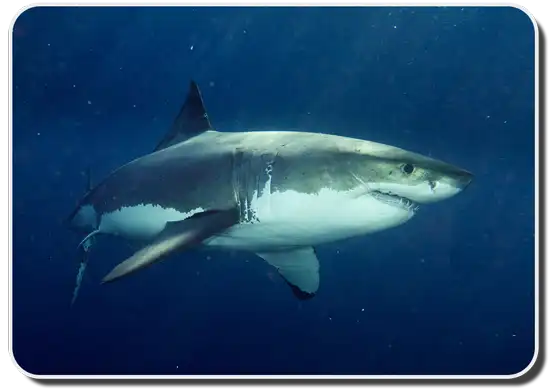
This creature is also known as the Carcharodon Carcharias, the White Shark, the White Pointer, or the White Death. This truly is an amazing creature and one of the most advanced predators in the animal kingdom. They look scary, are very powerful, have exceptional speed and maneuverability, and are expert hunters. It’s no wonder Hollywood portrays sharks as enemies! I guess you could say a Great White Shark is the king of all sharks, and, in general, is one of the oldest and most adaptable creatures on Earth.
The Great White Shark – What’s Behind The Name?
The name Great White comes from their snow-white ventral sides. However, the dorsal sides of their bodies are not white. In fact, the color of the Great Whites’ top portions is usually grey in order for them to blend in with the seafloor. Although, they can also be dark blue, brown or black. Great White Sharks have the typical torpedo-shape, aiding them with efficient swimming skills. These exceptional swimming abilities are only heightened by their powerful tails, which can propel them through the water at speeds of 15 mph (24 kmph)!
It’s awesome that this fish is such a great swimmer considering how heavy they are; their livers alone can take up 24% of their body weight. These massive, sleek sharks even have the ability to lurch out of the water with no problem whatsoever. If you’ve ever seen footage of a Great White on television, you’re probably already familiar with their incredible jumping skills.
Great White Sharks On National Geographic
Busting the Myth About Great White Shark Attacks
Great White Shark attacks are extremely rare, even when humans are swimming nearby. Humans are not specifically targeted by sharks and that includes the Great White. In the Mediterranean Sea, for example, there have only been 31 confirmed attacks against humans in the last two centuries, most non-fatal. They simply aren’t interested in us.
Why Attacks Happen?
First of all, it is almost never an “attack” against humans. Sharks, like other fish, will exhibit a behaviour called test biting. They were interested in what they saw and thought you might be a food source. Sharks almost never return again after an initial test bite on a human. That’s why fatalities from shark bites are so rare (most fatalities are caused by blood loss from an initial test bite).
On extremely rare occasions, sharks will attack a human. It is believed this only happens when the shark thinks your silhouette is a seal. But again, when the shark discovers you’re a person and not a seal, they quickly retreat. Humans have too many bones for a shark to digest, and sharks much prefer large, fatty animals like seals.
Finally, sharks by nature are not very territorial. So even when you’re swimming within very close proximity, they will leave you alone. The biggest issue when people see a shark is that they panic. Splashing around in the water makes you look like an injured animal (remember those “test bites” I was talking about?). If you remain calm and slowly swim away, chances are they won’t even notice you.
Do you still think the Great White is a man killing machine?
Size Of A Great White
The Great White Shark is one of the largest sharks in the ocean. Measuring up to 6.5 meters (more than 21 feet) is not uncommon. The largest Great White ever measured was over 7 meters long (23 feet). And get this, they can weigh 2 or even 3 metric tons in weight (that’s over 6,500 pounds)! That’s one big fish! Females are typically longer than males.
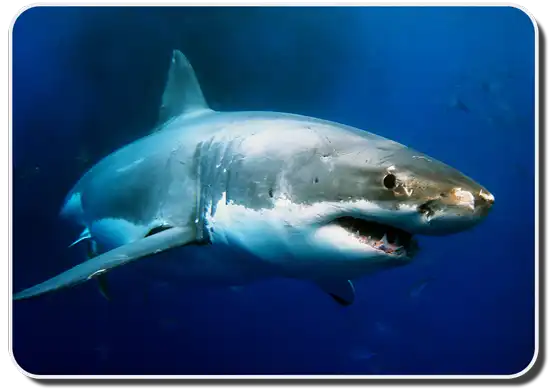
Great White Shark Diet – They Aren’t Picky Eaters
The Great White Shark has a diverse diet. These carnivorous creatures prey upon fish, such as tuna, rays, and other sharks, as well as cetaceans, which are dolphins, porpoises, and whales. They are also known to attack pinnipeds such as seals, fur seals, and sea lions, as well as sea turtles, sea otters, and seabirds.
Great White Shark pups will predominantly feed on fish since their jaws are not long enough to withstand the forces required to attack large animals such as seals and whales. Once they grow to about three meters in length, their jaw cartilage begins to strengthen, and they can begin to withstand the forces mentioned before. Once they grow to about four meters in length, the Great White Shark’s diet begins to expand. They will begin to target marine mammals for food since they prefer prey with high fat content.
Competition for food
When it comes to the way in which the Great White Sharks feed, there is a little known factor that is highly intriguing. These sharks do not like to fight over food. While I personally don’t want to have to fight for food either, many may be a bit surprised to learn that the Great Whites feel the same way because of their vicious image. When there are more than one of these sharks in the area and only enough food for one, they engage in a tail-slapping contest. The sharks slap the water’s surface as they swim around each other, thus sending a spray of water in the direction of the opposing sharks. The Great White who slaps the most wins the meal.
Hunting Behavior & Methods
Great White Sharks are very smart hunters. Generally, they use specific strategies to catch their prey, such as surprising their prey from below. By far, their preferred prey is a seal. But they also seem to like sea lions, some species of dolphins (mostly Humpback Dolphins) and select species of whales.
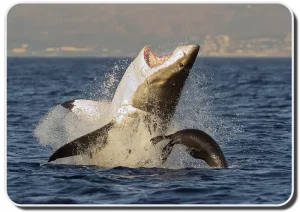
Great White Sharks are equipped with incredible noses, ears, and eyes in order to find its prey. These fish are extremely curious creatures, and may examine solitary, vulnerable, and unfamiliar objects to determine whether or not they are edible. This explains why humans have been attacked in the past. If the shark wants to examine potential prey, it will perform one of three methods. The first is the underwater approach, which is used the most often. The shark will swim under the surface until it’s just a few feet away from the prey. From there, it attacks quickly; moving its head to the surface to grab the victim. The second method is the surface charge, where the shark will swim partly our of the water until it makes its move of the prey. Lastly, the rarest method of hunting is the inverted method, where the shark swims on its back towards its prey.
Great White Teeth
Great White Sharks are famous for their teeth. Oftentimes when one thinks of a Great White, their large mouths and hundreds of huge, sharp teeth are the first images that come to mind. Believe it or not, these sharks have several rows that can hold up to approximately 300 serrated (jagged) teeth in their mouths at one time. In fact, Great Whites can loose up to 1,000 teeth in a lifespan! These factors make it so easy to understand why most are absolutely and completely terrified of these incredible predators.
Sense of Smell
The other features of the Great White are just as awesome and helpful as their mouths. Their sense of smell is so unbelievably acute, that they have the ability to smell a single drop of blood in 25 gal (100 L) of water. Not only that, but Great White Sharks can sense blood in the water up to 3 mi (5 km) away! This shark’s sense of smell is almost unreal. You would think that this was more than enough to aid the Great White Shark in finding and demolishing prey, but no, there’s more. They can also sense animal generated electromagnetic fields.
Eye Protection
The animals that become victims of the Great White are not known to just give up and die; they fight for their lives. Therefore, it is not uncommon to find scars and scratches upon the snouts of many Great Whites. Luckily for the sharks, they have yet another mechanism concerning their eyes that helps to protect them from struggling prey, or anything else that may harm them. These sharks can actually roll their eyes back, thus preventing the most vital parts of the eye from being scratched. How cool is that!
Average Age Of A Great White
Most Great Whites can live up to 30-70 years. But there is still quite a bit of mystery surrounding the growth, development, and social behaviors as well as how offspring are raised (if they are “raised” at all, that is).
Its roots can be traced back to ancient times. The Great White may have derived from the Megalodon Shark but others believe the Mako Shark was its predecessor.
Great White Shark Reproduction
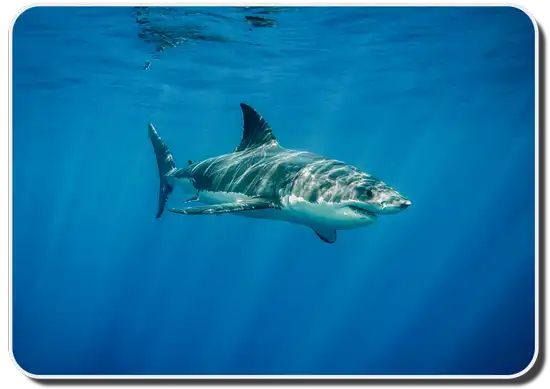
One of the issues with Great White Sharks is their ability to reproduce. There are several factors that are unknown when discussing Great White Shark reproduction. What we can infer is that the Great White Shark reproduction process is long, sparse, and doesn’t yield enough offspring to remain off the endangered list.
The Birthing Process
Here is what we know so far regarding the Great White Shark reproduction process. The Great White Shark is ovoviviparous. In other words, a shark grows inside an egg and hatches inside the mother. Afterward, the shark pup is born. While they are still in the womb, the shark pup will feed on the unfertilized eggs in order to keep growing. This method of feeding is known as oophagy.
The gestation period takes longer than what we are used to. It is estimated that the Whale Shark pregnancy cycle is about 12 to 18 months. The size of the litter can vary for great white sharks, but the common range is about two to ten pups. However, there have been reports of litters carrying around 17 pups.
When they are born, Great White Shark pups will measure around 5 feet (1.5 meters) and weigh about 77 pounds (35 kilograms). These sharks grow slowly and take considerable time to mature and produce offspring. Males are able to reach maturity at the age of 9 or 10, while females mature at ages 14-16. It is believed by scientists that these sharks can live up to 70 years. With that in mind, Great White Shark reproduction can only occur during a relatively short timeframe.
Because of the long gestation period, it’s possible that female Great Wwhites give birth every other year, taking some time to rest after mating. This low reproductive rate and slow growth to maturity are concerns to Great White conservationists. Scientists are interested in learning more about the shark’s reproductive habits so that they will know better what conservation methods are needed.
Habitat
Although Great White Sharks love the coastal areas in all oceans from all over the world, they typically live on the outskirts of shore waters. Sometimes, they stray into the deep Ocean and are even found in depths of 1000 meters (3,280ft) or more! But their preferred water temperature is from 15C to 24C (59F to 75F), so most of the time they stay in shallow waters and near the surface.
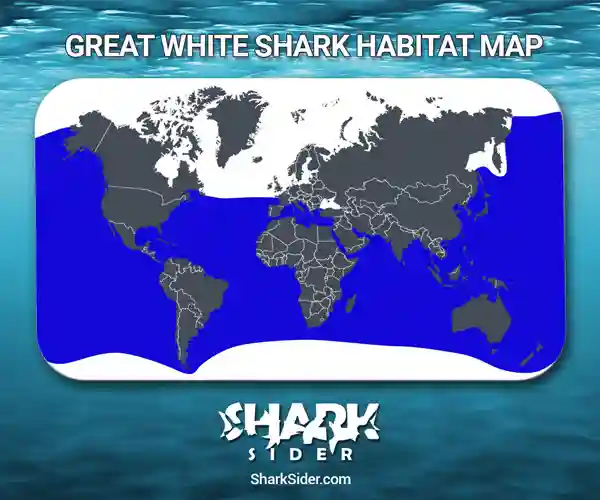 Sensory System
Sensory System
Like all other shark species, Great White Sharks have a special sense of feeling in what is known as the Ampullae of Lerenzini. Basically, they are electro receptors, forming a network of jelly filled pores.
This electro receptor allows them to track their prey through their mouths. So whenever a potential prey is moving, the Great White can pick up on its electric field.
Their sensitivity is so great that they can actually sense a half a billionth of 1 volt. That means, if you’re in the ocean and remain completely still, the shark can pick up on your beating heart from several miles away. Isn’t that amazing!?
Socialization
The structure and behavior of the Great White social network is still a big mystery.
Normally, they are mavericks and loners. Free thinkers who spend much time alone. When they do meet or swim in groups, they typically avoid conflict and dominance battles.
However, there are places, such as the waters around Africa, where Great White Sharks show a distinct hierarchy. Females tend to dominate males and larger sharks dominate smaller ones. Local sharks seem to dominate newcomers and in order to show strength, more dominant sharks may give warning bites to the submissive’s. As with many other predators, cannibalism does occur, although it’s believed to be a rare occurrence.
Human Interaction
Although there are many movies and television shows depicting the horrors of Great White Sharks and the horrible things that they do to humans, the truth is these sharks really are not interested in human flesh. There have definitely been shark attacks, however, it is very rare for attacks to be fatal to the human. When a Great White attacks a human, it is usually a mistake. People can very easily be mistaken as a sea lion or a seal from below; therefore the shark goes after them not realizing who they are. This is why these attacks rarely end in the death of a person. Once the shark realizes that they are indeed attacking a person, they back off. This may not be what is shown in thriller movies, but it is the truth.
Not only are these sharks not interested in eating humans, but also it is in people’s best interests to not desire to eat Great White Sharks. They have extremely high levels of mercury in their bodies, thus making Great White meat unsafe for human consumption. Despite the fact that humans do not typically eat Great Whites for this reason, they still happen to be overfished and Bycatch victims, thus making them an endangered species. Unfortunately, there is not a lot of available information regarding the actual population of these sharks, but it is believed by some scientists that there are less than 10,000 Great White Sharks left in the world. We can only hope that this problem is soon resolved as they play a very important role in the fragile aquatic ecosystem.
50 Cool Facts About Great White Sharks
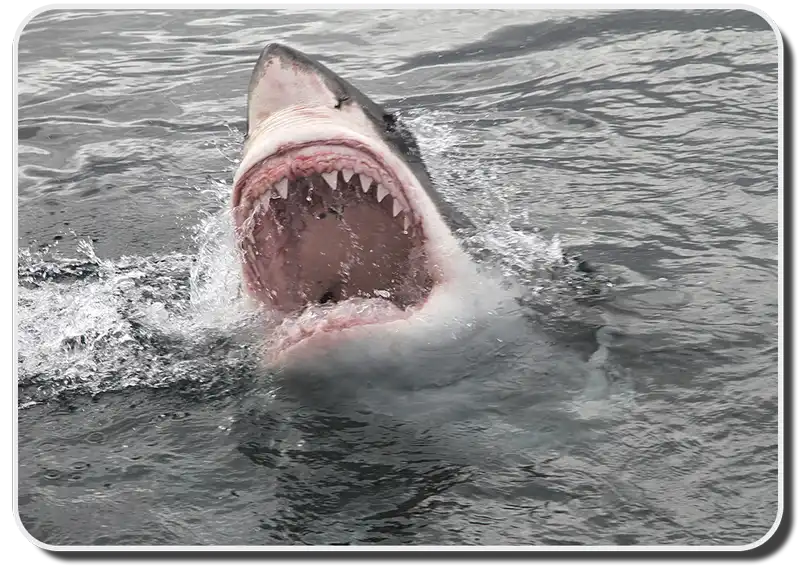 Does any other shark capture our imagination like the Great White? As the largest predatory fish in our ocean, these fearsome animals inspire awe and respect. Here are 50 cool facts about these incredible creatures:
Does any other shark capture our imagination like the Great White? As the largest predatory fish in our ocean, these fearsome animals inspire awe and respect. Here are 50 cool facts about these incredible creatures:
- Great White Sharks live and hunt on the coast of every continent in the world the except Antarctica.
- They generally prefer to live in cooler waters that have temperatures ranging from 54-75° fahrenheit.
- Most of the world’s Great White Sharks live off the coast of Dyer Island, in South Africa, this area is also referred to as “Shark Alley.”
- Though they tend stay to close to the shore in shallower waters, they have been spotted swimming in open waters at depths of up to 3,900 feet.
- Early fossil records show that Great White Sharks have been swimming in Earth’s oceans for around 16 million years, though scientists believe they may be much older.
- Scientists previously thought the life expectancy of a Great White Shark was around 25 years, but a recent study shows that their life expectancy is actually around 70 years.
- Great White Sharks weigh an average of 1,500-2,400 pounds at maturity, about one ton.
- The heaviest Great White Shark ever recorded in the wild was estimated to weigh in at a whopping 7,328 pounds.
- Like most shark species, female Great White Sharks grow much larger than the males.
- Typically, Great White Sharks can grow up to 21 feet in length, though females average at 15-16 feet long and males average at 11-13 feet long.
- The largest Great White Shark ever recorded in the wild was estimated to be 26 feet long, more than half the length of a basketball court.
- Caught off the coast of Kangaroo Island in Australia, the largest captured Great White Shark was 23.4 feet long.
- There have been claims of larger Great White Sharks, but they have mostly turned out to be Basking Sharks which are very similar in appearance.
- In a single year, Great White Sharks eat average of 11 tons of food.
- Once they have fed, Great White Sharks can go a whole three months without having to eat another meal.
- Clocking in at speeds up to 35 mph, Great White Sharks are some of the fastest predators in the oceans.
- Sharks have six senses: Sight, smell, touch, taste, hearing, and electroreception.
- They use electromagnetic fields to feel vibrations in the water of potential prey.
- In close range, they can even sense the heartbeat of immobile prey.
- Their sense of smell is so good they can detect the scent of blood in the water from up to three miles away.
- They do not have eyelids, instead their eyes roll back into their heads to protect them from damage when attacking prey.
- Great White Sharks eat a wide range of animals from Elephant Seals to seabirds to even crocodiles.
- They are also known cannibals and will eat other Great White Sharks, especially in territorial disputes.
- A Great White Shark has a bite force of 4,000 psi, that is 10 times the bite force of a lion.
- Though predominantly hunters, they will also scavenge and eat the carcasses of dead animals when they cannot find prey.
- Great White Sharks tend to hunt first thing in the morning, within the first two hours of sunrise when visibility is low.
- Utilizing a practice known as “spy-hopping,” Great White Sharks will often peak their heads above water to look for prey.
- They can jump up to ten feet above the water surface to catch and kill prey, a behavior known as “breaching.”
- Their average breach speed occurs at 25 mph.
- They have been known to accidentally breach onto the decks of boats.
- Great White Sharks use a type of camouflage called countershading that makes them hard to see in the water.
- Inside their mouths, Great White Sharks have 5 rows of teeth with 46 teeth in each row.
- The largest Great White Shark tooth ever found was 3.5 inches long, about the size of the palm of a human hand.
- As sharp as knives, Great White Shark teeth are serrated to easily tear into flesh.
- Great White Sharks do not get cavities, but they will lose and regrow hundreds of teeth in their lifetimes.
- They tend to bite their prey, leave and let them weaken, before returning and finishing the kill.
- Great White Sharks are also known to grab and shake their prey side to side to weaken and injure it.
- Great White Sharks are typically solitary hunters, spending most of their lives alone except during mating season.
- Sometimes during mating season Great White Sharks will share food, engaging in pack feeding of up to 8 sharks sharing the same meal.
- Little is known about the mating rituals of Great White Sharks, though after copulation female sharks are often covered in bite marks.
- Female Great White Sharks are pregnant for 11 months, giving birth to small litters of 2-12 pups.
- Baby sharks practice oophagy, a behavior where the largest, strong pups will cannibalize the other pups inside of the womb.
- Though an apex predator, Great White Sharks are often attacked and eaten by Killer Whales.
- Great White Sharks become motionless when flipped on their backs, known as “tonic immobility.”
- Killer Whales use tonic mobility to attack and kill a Great White Shark, deliberately ramming it until it flips on its back and stops breathing.
- When Great White Sharks smell the blood of another Great White Shark, they will immediately leave the area, sometimes swimming hundreds of miles away.
- Great White Sharks are responsible for the most attacks on people of any other species of shark, though they will not eat people.
- Most people survive Great White Shark attacks because typically, after mistaking a person for prey, a shark will take a bite, realize their mistake, and swim away.
- They will often attack and capsize boats because they are drawn to the electric fields they generate.
- Great White Sharks cannot be kept in captivity because they become disoriented and will stop eating and continuously run into the aquarium walls until they die.
